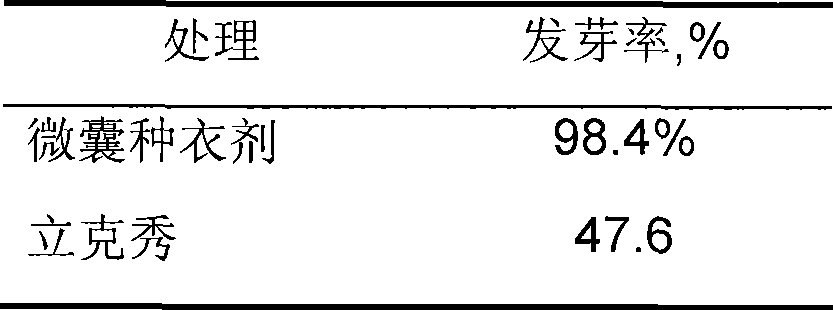Functional slow-release suspension seed-coating agents
A functional, slow-release technology, applied in the direction of seed coating/seed dressing, biocide, biocide, etc., can solve the problems of exposure to phytotoxicity and being easily affected by external adverse factors.
- Summary
- Abstract
- Description
- Claims
- Application Information
AI Technical Summary
Problems solved by technology
Method used
Image
Examples
Embodiment 1
[0036] The first step Microencapsulation
[0037] (1) Water phase preparation: add emulsion stabilizer hydroxyethyl cellulose (FD 2000) into deionized water, prepare 80 ml of 1.2% aqueous solution, then add 2.0 g of emulsifier 0203, stir to dissolve it completely
[0038] (2) Organic phase preparation: mix 1 gram of polymethyl methacrylate and 1 gram of tebuconazole in 20 ml of dichloromethane, stir to fully dissolve and mix well
[0039] (3) Emulsification: Pour the organic phase of dichloromethane containing polymethyl methacrylate and tebuconazole into the water phase, high-speed shear emulsification until the droplet diameter of the emulsion is below 5 microns, and the solution is a white emulsion . In the process of high-speed shear emulsification, if the temperature of the emulsion rises too fast, it can be properly cooled with an ice bath to reduce the volatilization of organic solvents
[0040] (4) Microencapsulation: Stir the above emulsion at room temperature (mech...
Embodiment 2
[0044] The first step Microencapsulation
[0045] (1) Water phase preparation: Add the emulsion stabilizer hydroxyethyl cellulose (FD 2000) into deionized water to prepare 75.5 ml of 1.2% aqueous solution, then add 2.0 g of emulsifier 1601, and stir to dissolve it completely
[0046] (2) Organic phase preparation: put 3.0 grams of polystyrene and 3.0 grams of difenoconazole in 50 milliliters of dichloromethane, stir to fully dissolve and mix well
[0047] (3) Emulsification: Pour the dichloromethane organic phase containing polystyrene and difenoconazole into the water phase, high-speed shear emulsification and emulsification under ice bath cooling until the droplet diameter of the emulsion is below 5 microns, and the solution white emulsion
[0048] (4) Microencapsulation: Stir the above emulsion at room temperature (mechanical stirring), during which dichloromethane gradually volatilizes, and after 4 hours, gradually raise the reaction temperature to 40°C to completely remo...
Embodiment 3
[0052] The first step Microencapsulation
[0053] (1) Water phase preparation: Add the emulsion stabilizer hydroxypropyl cellulose to deionized water to prepare 73.0 ml of 1.8% aqueous solution, then add 2.0 g of emulsifier 603 and 0.7 g of emulsifier 500#, and stir to dissolve it completely
[0054] (2) Organic phase preparation: put 3 grams of polystyrene-maleic anhydride alternating copolymer and 3 grams of myclobutanil in 50 milliliters of butyl acetate, stir to make it fully dissolved
[0055] (3) Emulsification: Pour the butyl acetate organic phase containing polystyrene-maleic anhydride alternating copolymer and myclobutanil into the water phase, and emulsify under high-speed shear emulsification until the droplet diameter of the emulsion is Below 5 microns, the solution is white emulsion
[0056] (4) Microencapsulation: Stir the above emulsion at room temperature (mechanical stirring), stir under reduced pressure at 10mm Hg for 3 hours, gradually increase the reaction...
PUM
 Login to View More
Login to View More Abstract
Description
Claims
Application Information
 Login to View More
Login to View More - R&D
- Intellectual Property
- Life Sciences
- Materials
- Tech Scout
- Unparalleled Data Quality
- Higher Quality Content
- 60% Fewer Hallucinations
Browse by: Latest US Patents, China's latest patents, Technical Efficacy Thesaurus, Application Domain, Technology Topic, Popular Technical Reports.
© 2025 PatSnap. All rights reserved.Legal|Privacy policy|Modern Slavery Act Transparency Statement|Sitemap|About US| Contact US: help@patsnap.com


